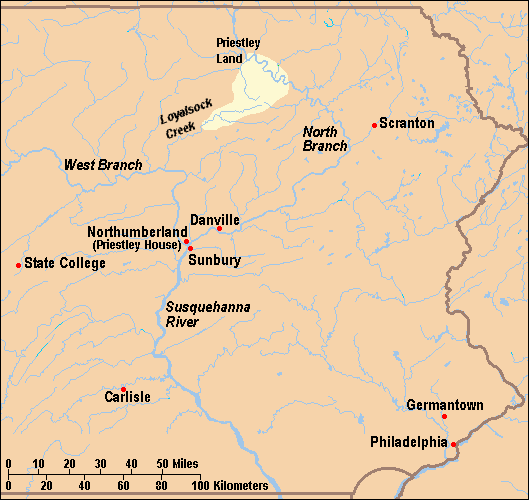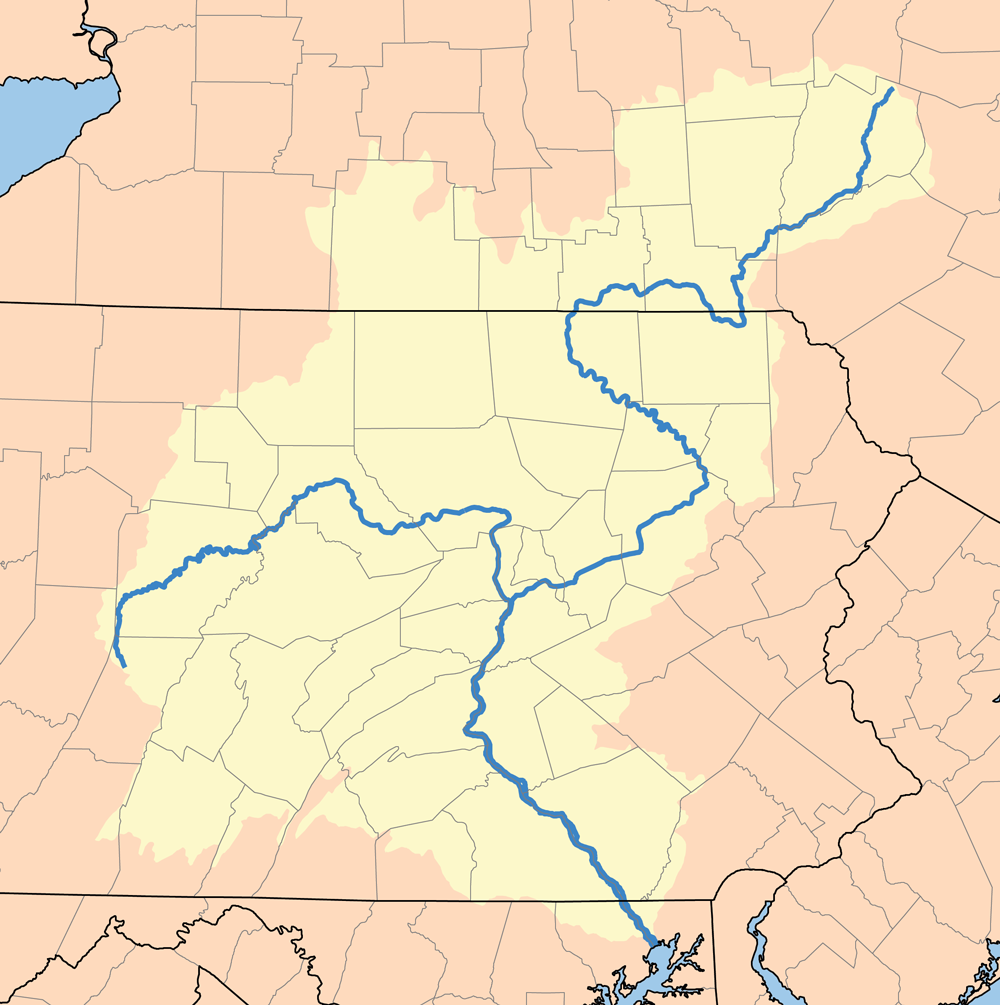|
Joseph Priestley House
The Joseph Priestley House was the American home of 18th-century British theologian, Dissenting clergyman, natural philosopher (and discoverer of oxygen), educator, and political theorist Joseph Priestley (1733–1804) from 1798 until his death. Located in Northumberland, Pennsylvania, the house, which was designed by Priestley's wife Mary, is Georgian with Federalist accents. The Pennsylvania Historical and Museum Commission (PHMC) operated it as a museum dedicated to Joseph Priestley from 1970 to August 2009, when it closed due to low visitation and budget cuts. The house reopened in October 2009, still owned by the PHMC but operated by the Friends of Joseph Priestley House (FJPH). Fleeing religious persecution and political turmoil in Britain, the Priestleys emigrated to the United States in 1794 seeking a peaceful life. Hoping to avoid the political troubles that had plagued them in Britain and the problems of urban life they saw in the United States, the Priestleys built a ... [...More Info...] [...Related Items...] OR: [Wikipedia] [Google] [Baidu] |
Northumberland, Pennsylvania
Northumberland is a borough in Northumberland County, Pennsylvania, United States. The population was 3,804 at the 2010 census. History A brewer named Reuben Haines, a native of Philadelphia, Pennsylvania, founded the town of Northumberland in 1772, attempting to set it up as an English village. The land that became Northumberland was purchased from the Iroquois in the first Treaty of Fort Stanwix in 1768, and the village was laid out in 1772. During the American Revolution, Northumberland was evacuated during the Big Runaway in 1778, and only finally resettled in 1784.National Register of Historic Places Registration: Northumberland Historic District . Northumberland was the American home of eighteenth-century British |
Susquehanna Valley
The Susquehanna Valley is a region of low-lying land that borders the Susquehanna River in the United States, U.S. states of New York (state), New York, Pennsylvania, and Maryland. The valley consists of areas that lie along the main branch of the river, which flows from Upstate New York through Pennsylvania and Maryland into the Chesapeake Bay, as well as areas that lie along the shorter West Branch Susquehanna River, West Branch in Pennsylvania. Communities in the valley Main Branch Cities * Oneonta, New York * Binghamton, New York * Wilkes-Barre, Pennsylvania * Scranton, Pennsylvania * Sunbury, Pennsylvania * Harrisburg, Pennsylvania * York, Pennsylvania * Havre de Grace, Maryland Counties * Otsego County, New York * Delaware County, New York * Chenango County, New York * Broome County, New York * Susquehanna County, Pennsylvania * Tioga County, New York * Bradford County, Pennsylvania * Wyoming County, Pennsylvania * Lackawanna County, Pennsylvania * Luzerne Cou ... [...More Info...] [...Related Items...] OR: [Wikipedia] [Google] [Baidu] |
Priestley House Northumberland Map
Priestley may refer to: Places * Priestley, West Virginia, US, an unincorporated community * Priestley Glacier, a major valley glacier in Antarctica * Priestley (lunar crater), on the far side of the Moon * Priestley (Martian crater) * 5577 Priestley, an inner main belt asteroid People Arts * Alice Priestley (born 1962), Canadian children's writer and illustrator * Brian Priestley (born 1940), English jazz writer, pianist and arranger * Chris Priestley (born 1958), British children's book author and illustrator * Jason Priestley (born 1969), Canadian-American actor * J. B. Priestley (1894–1984), English writer and broadcaster * Mark Priestley (1976–2008), Australian actor *Rick Priestley (born 1959), British miniature wargame designer and author * Robert Priestley (1901–1986), American set decorator * Tom Priestley (born 1932), sound and film editor Sciences * Henry Priestley (biochemist) (1884–1961), Australian biochemist * Hilary Priestley, British mathematician ... [...More Info...] [...Related Items...] OR: [Wikipedia] [Google] [Baidu] |
Potash
Potash () includes various mined and manufactured salts that contain potassium in water-soluble form.Potash USGS 2008 Minerals Yearbook The name derives from ''pot ash'', plant ashes or soaked in water in a pot, the primary means of manufacturing potash before the . The word '''' is derived from ''potash''. Potash is produced worldwide in amounts exceeding 90 million |
Pottery
Pottery is the process and the products of forming vessels and other objects with clay and other ceramic materials, which are fired at high temperatures to give them a hard and durable form. Major types include earthenware, stoneware and porcelain. The place where such wares are made by a ''potter'' is also called a ''pottery'' (plural "potteries"). The definition of ''pottery'', used by the ASTM International, is "all fired ceramic wares that contain clay when formed, except technical, structural, and refractory products". In art history and archaeology, especially of ancient and prehistoric periods, "pottery" often means vessels only, and sculpted figurines of the same material are called "terracottas". Pottery is one of the oldest human inventions, originating before the Neolithic period, with ceramic objects like the Gravettian culture Venus of Dolní Věstonice figurine discovered in the Czech Republic dating back to 29,000–25,000 BC, and pottery vessels that were ... [...More Info...] [...Related Items...] OR: [Wikipedia] [Google] [Baidu] |
Brewery
A brewery or brewing company is a business that makes and sells beer. The place at which beer is commercially made is either called a brewery or a beerhouse, where distinct sets of brewing equipment are called plant. The commercial brewing of beer has taken place since at least 2500 BC; in ancient Mesopotamia, brewers derived social sanction and divine protection from the goddess Ninkasi. Brewing was initially a cottage industry, with production taking place at home; by the ninth century, monasteries and farms would produce beer on a larger scale, selling the excess; and by the eleventh and twelfth centuries larger, dedicated breweries with eight to ten workers were being built. The diversity of size in breweries is matched by the diversity of processes, degrees of automation, and kinds of beer produced in breweries. A brewery is typically divided into distinct sections, with each section reserved for one part of the brewing process. History Beer may have been known in Neol ... [...More Info...] [...Related Items...] OR: [Wikipedia] [Google] [Baidu] |
Methodism
Methodism, also called the Methodist movement, is a group of historically related denominations of Protestant Christianity whose origins, doctrine and practice derive from the life and teachings of John Wesley. George Whitefield and John's brother Charles Wesley were also significant early leaders in the movement. They were named ''Methodists'' for "the methodical way in which they carried out their Christian faith". Methodism originated as a revival movement within the 18th-century Church of England and became a separate denomination after Wesley's death. The movement spread throughout the British Empire, the United States, and beyond because of vigorous missionary work, today claiming approximately 80 million adherents worldwide. Wesleyan theology, which is upheld by the Methodist churches, focuses on sanctification and the transforming effect of faith on the character of a Christian. Distinguishing doctrines include the new birth, assurance, imparted righteousness, ... [...More Info...] [...Related Items...] OR: [Wikipedia] [Google] [Baidu] |
Quaker
Quakers are people who belong to a historically Protestant Christian set of Christian denomination, denominations known formally as the Religious Society of Friends. Members of these movements ("theFriends") are generally united by a belief in each human's ability to experience Inward light, the light within or see "that of God in every one". Some profess a priesthood of all believers inspired by the First Epistle of Peter. They include those with evangelicalism, evangelical, Holiness movement, holiness, Mainline Protestant, liberal, and Conservative Friends, traditional Quaker understandings of Christianity. There are also Nontheist Quakers, whose spiritual practice does not rely on the existence of God. To differing extents, the Friends avoid creeds and Hierarchical structure, hierarchical structures. In 2017, there were an estimated 377,557 adult Quakers, 49% of them in Africa. Some 89% of Quakers worldwide belong to ''evangelical'' and ''programmed'' branches that hold ... [...More Info...] [...Related Items...] OR: [Wikipedia] [Google] [Baidu] |
Big Runaway
The Big Runaway was a mass evacuation in June and July 1778 of settlers from the frontier areas of north central Pennsylvania during the American Revolutionary War. A major campaign by Loyalists and Native Americans allied with the British devastated the small communities on the northern and western branches of the Susquehanna River, prompting local militia leaders to order the evacuation. Most of the settlers relocated to Fort Augusta at modern-day Sunbury at the confluence of the North and West Branches of the Susquehanna River, while their abandoned houses and farms were all burnt. Some settlers returned soon after, but the attacks were renewed the following year, leading to a second evacuation known as The Little Runaway. These attacks on the Pennsylvania frontier led to retaliatory scorched earth tactics by the American army against the Native Americans, including Sullivan's Expedition, which destroyed more than 40 Iroquois villages. Background In 1768, the Colony of ... [...More Info...] [...Related Items...] OR: [Wikipedia] [Google] [Baidu] |
American Revolution
The American Revolution was an ideological and political revolution that occurred in British America between 1765 and 1791. The Americans in the Thirteen Colonies formed independent states that defeated the British in the American Revolutionary War (1775–1783), gaining independence from the British Crown and establishing the United States of America as the first nation-state founded on Enlightenment principles of liberal democracy. American colonists objected to being taxed by the Parliament of Great Britain, a body in which they had no direct representation. Before the 1760s, Britain's American colonies had enjoyed a high level of autonomy in their internal affairs, which were locally governed by colonial legislatures. During the 1760s, however, the British Parliament passed a number of acts that were intended to bring the American colonies under more direct rule from the British metropole and increasingly intertwine the economies of the colonies with those of Brit ... [...More Info...] [...Related Items...] OR: [Wikipedia] [Google] [Baidu] |
Treaty Of Fort Stanwix
The Treaty of Fort Stanwix was a treaty signed between representatives from the Iroquois and Great Britain (accompanied by negotiators from New Jersey, Virginia and Pennsylvania) in 1768 at Fort Stanwix. It was negotiated between Sir William Johnson, his deputy George Croghan, and representatives of the Iroquois. The treaty established a Line of Property following the Ohio River that ceded the Kentucky portion of the Virginia Colony to the British Crown, as well as most of what is now West Virginia. The treaty also settled land claims between the Iroquois and the Penn family; the lands thereby acquired by American colonists in Pennsylvania were known as the New Purchase. Treaty The purpose of the conference was to adjust the boundary line between Indian lands and the Thirteen Colonies set forth in the Royal Proclamation of 1763. The British government hoped a new boundary line might bring an end to the rampant frontier violence between Native Americans and American colonists. ... [...More Info...] [...Related Items...] OR: [Wikipedia] [Google] [Baidu] |
Province Of Pennsylvania
The Province of Pennsylvania, also known as the Pennsylvania Colony, was a British North American colony founded by William Penn after receiving a land grant from Charles II of England in 1681. The name Pennsylvania ("Penn's Woods") refers to William's father, Admiral Sir William Penn. The Province of Pennsylvania was one of the two major Restoration colonies. The proprietary colony's charter remained in the hands of the Penn family until they were ousted by the American Revolution, when the Commonwealth of Pennsylvania was created and became one of the original thirteen states. " The lower counties on Delaware," a separate colony within the province, broke away during the American Revolution as " the Delaware State" and was also one of the original thirteen states. The colony attracted Quakers, Germans, and Scots-Irish frontiersmen. The Lenape promoted peace with the Quakers. However, wars eventually broke out after William Penn and Tamanend were no longer living. Lenape ... [...More Info...] [...Related Items...] OR: [Wikipedia] [Google] [Baidu] |





.jpg)

